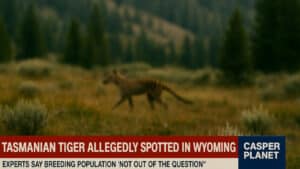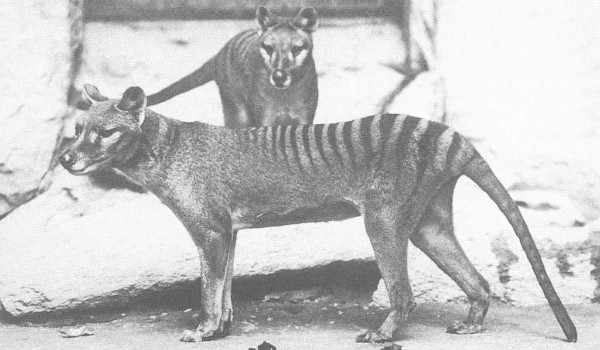
Could a creature declared extinct nearly a century ago be roaming the rugged wilderness of Wyoming?
A recent trail cam photo from the Bighorn Mountains, first shared by Casper Planet on Facebook has reignited fascination with the Tasmanian tiger, or thylacine, a marsupial predator long thought lost to history.
The blurry image of a striped, dog-like creature has sparked debate among locals, wildlife experts, and cryptid enthusiasts. Is this a case of mistaken identity, or could a surviving population be hiding in America’s vast backcountry?
Let’s explore the thylacine’s history, its extinction, the Wyoming sighting, how it might have reached the U.S., and whether it could thrive here.
The Thylacine: A Vanished Marvel
The Tasmanian tiger was no tiger at all but a marsupial, roughly the size of a large dog, with a wolf-like head, distinctive dark stripes across its back and hindquarters, and a stiff, kangaroo-like tail. Its scientific name, Thylacinus cynocephalus (dog-headed pouched one), hints at its unique blend of canine and marsupial traits. Native to Tasmania, mainland Australia, and New Guinea, thylacines were apex predators, hunting small mammals, birds, and possibly larger prey like wallabies. Their elusive nature and nocturnal habits made them a mystery even in their prime.
By the 19th century, European settlement in Tasmania spelled doom for the thylacine. Farmers blamed them for livestock losses, though evidence suggests they preferred native prey. Bounties were placed on their heads, with over 2,000 thylacines killed between 1888 and 1909 under government programs. Habitat destruction, competition with introduced dogs, and disease further eroded their numbers. The last known thylacine, named Benjamin, died in captivity at the Hobart Zoo in 1936, marking the species’ official extinction.

Yet, the thylacine’s story didn’t end there. Sightings have persisted in Tasmania and mainland Australia, often accompanied by grainy photos or shaky videos—none conclusively verified. These reports, coupled with the thylacine’s cultural significance, have fueled modern efforts to resurrect the species through genetic engineering.
Projects like those at the University of Melbourne aim to reconstruct thylacine DNA, but no living specimen has been confirmed in nearly a century. Could Wyoming hold the key to rewriting this tale?
Never Miss A Paranormal Story!
Newsletter subscribers get insider access to the latest paranormal posts!
Your email is safe with us and you can unsubscribe at any time!
The Wyoming Sighting: A Cryptid Resurfaces
On a crisp fall day in 2024, elk hunter Calvin Marsh set up a trail camera in Wyoming’s Bighorn Mountains, hoping to track game. What he captured instead was a creature that defied explanation. The image, shared by Casper Planet on Facebook, showed a lean, dog-sized animal with faint stripes along its back and a rigid, elongated tail. Marsh, an experienced outdoorsman, was baffled. “I’ve seen every kind of predator out here,” he told Casper Planet. “This thing moved different. It didn’t run like a wolf or a coyote. It kind of… glided. And when I saw the tail, I about dropped my scope.”
The Wyoming Department of Game and Fish took notice, calling the photo “worth investigating.” They’ve since closed the area to recreational trapping and predator hunts, installing additional cameras to verify the sighting. Local ranchers have added to the intrigue, reporting odd incidents in recent months: livestock pens broken into with no animals taken, bite marks on wooden fences, and missing dog food. One rancher, unnamed in the report, claimed his trail cam caught a “striped ghost dog” eating his cat’s kibble under the porch.
The Casper Planet post, titled “Tasmanian Tiger Allegedly Spotted in Wyoming Wilderness,” went viral, amassing hundreds of comments. Wyoming resident Sarah T. wrote, “I saw something like this near Cody last year! Thought it was a sick coyote, but the stripes were too clear.”
Another commenter, Jake R., added, “My grandpa used to talk about ‘weird dogs’ in the mountains back in the ‘70s. Maybe this is what he meant?”
Skeptics chimed in too, with Lisa M. noting, “Looks like a mangy coyote to me. People see what they want to see.” The range of reactions—from excitement to doubt—mirrors the broader debate over cryptid sightings.
A Historical Conspiracy: The SS Black Pine
The notion of a Tasmanian tiger in Wyoming seems fantastical, but a shadowy historical tale offers a potential explanation. In 1948, a cargo ship named the SS Black Pine reportedly ran aground off the coast of Maine during a violent nor’easter. According to unconfirmed manifests, later uncovered by amateur historians, the vessel was carrying “biological cargo” from Tasmania to a secretive U.S. wildlife facility, possibly for research or private zoological collections. Among the rumored cargo? Live thylacines, smuggled out of Tasmania years after their supposed extinction. If true, escaped survivors could have seeded a population in North America.
However, the SS Black Pine story is steeped in uncertainty. Maritime records from the period are incomplete, and no definitive evidence confirms the ship’s existence or its wreck. Some researchers argue the Black Pine is a myth, born from cryptic references in declassified government documents about wildlife experiments in the mid-20th century. Others point to local Maine folklore, which describes “strange beasts” sighted in coastal forests post-1948, as circumstantial support. The manifests, often cited by cryptozoologists, have never been authenticated, and critics note they could be fabrications or misinterpretations of mundane cargo lists.
Despite these doubts, Dr. Meredith Connors, a zoologist quoted by Casper Planet, sees potential in the theory. “It’s not implausible that some thylacines survived and dispersed,” she said. “The Appalachians and Rockies are vast, largely unmonitored corridors. If even a few pairs made it out, it’s conceivable a population could have slowly migrated west over generations.” Connors acknowledges the Black Pine’s unverified status but argues that even a single undocumented transport could explain the Wyoming sighting. “If this is real, we’re not looking at a one-off,” she added. “We’re looking at a surviving bloodline. That means they’re breeding.”
The Black Pine theory, while compelling, remains speculative. Similar stories of escaped exotic animals—like red kangaroos in the U.S. Midwest—lend it some credibility, but without concrete records, it teeters on the edge of legend. Still, the idea of thylacines slipping into America’s wilderness via a lost ship captures the imagination, fueling the mystery of Wyoming’s striped stranger.
Could Thylacines Survive in America?
The Bighorn Mountains, with their dense forests, rocky outcrops, and abundant prey, bear striking similarities to the thylacine’s native Tasmanian wilderness. Deer, elk, rabbits, and small rodents could sustain a small population of these adaptable predators. Thylacines were known to hunt alone or in pairs, targeting prey with stealth and precision. Their nocturnal habits and elusive nature would make them masters at avoiding human detection, especially in remote areas.
Climate poses a potential challenge. Wyoming’s harsh winters, with temperatures dropping below zero, differ from Tasmania’s milder conditions. However, thylacines had thick fur and a robust build, suggesting they could adapt to colder environments. Their ability to scavenge—evidenced by reports of the “striped ghost dog” eating kibble—would further aid survival in lean times.
A bigger hurdle is population size. A viable breeding population requires enough individuals to maintain genetic diversity and avoid inbreeding. If only a handful of thylacines escaped in 1948, their descendants might face genetic bottlenecks. Yet, the Rockies’ vastness—spanning millions of acres across multiple states—could conceal a small, secretive group for decades. Similar cryptids, like the eastern cougar, have persisted in small numbers despite being declared extinct in some regions.
Dr. Connors points to the thylacine’s resilience: “These were tough animals. They survived in Tasmania’s wilds for thousands of years, dodging dingoes and human hunters. If they made it to America, they’d find a way to hang on.” Commenter Mike D. on the Casper Planet post echoed this sentiment: “If wolves can come back from nothing, why not these guys? Those mountains are huge, and we don’t know half of what’s out there.”
The Bigger Picture: Cryptids and Human Imagination
The Wyoming sighting taps into a broader fascination with cryptids—creatures that exist on the edge of science and folklore. From Bigfoot to the Loch Ness Monster, these mysteries challenge our understanding of the natural world. The thylacine, with its tragic extinction and persistent sightings, occupies a unique space: a documented species that could, in theory, still exist. Unlike purely mythical creatures, the thylacine has a tangible history, making sightings like Wyoming’s all the more tantalizing.
Skeptics argue the trail cam image could depict a coyote with mange, a wolf hybrid, or even a hoax. Coyotes with severe mange often appear thin and hairless, with skin patterns that might mimic stripes in low light. Yet, Marsh’s description of the creature’s “gliding” movement and rigid tail doesn’t align with canine behavior. Thylacines had a distinctive gait, with a hopping motion akin to kangaroos, setting them apart from wolves or coyotes.
The Casper Planet post has also drawn parallels to other unexplained phenomena in Wyoming, like livestock mutilations and strange lights in the sky. Commenter Tara L. wrote, “First the UFO stuff in Laramie, now this? Wyoming’s getting weird.” While these connections are speculative, they highlight how cryptid sightings often intertwine with local lore, amplifying their cultural impact.
You Might Also Like:
What’s Next for the Wyoming Thylacine?
The Wyoming Department of Game and Fish is taking the sighting seriously, with plans to analyze the trail cam footage and collect environmental DNA from the site. If thylacine DNA is found, it would be a groundbreaking discovery, rewriting the species’ history. Even if the creature turns out to be something else, the sighting has sparked valuable discussion about conservation and the possibility of rediscovering “extinct” species.
For now, the Bighorn Mountains remain a place of mystery. The trail cam image, though blurry, captures something extraordinary—a glimpse of what might be. As Dr. Connors put it, “The truth is out there, and it’s probably got stripes.”
Have you encountered strange creatures in the wild?
Share your stories with us at Reports@ParaRational.com.












One Response